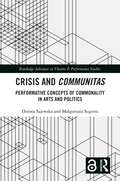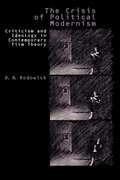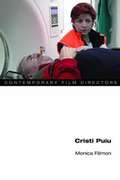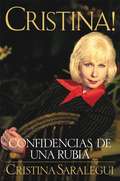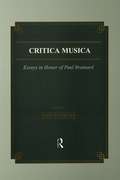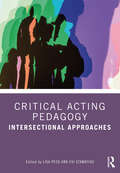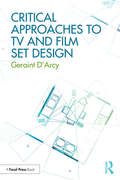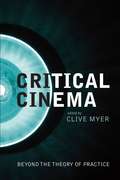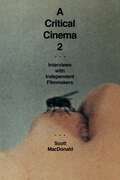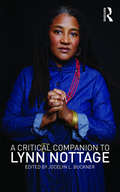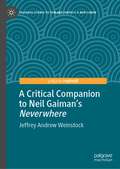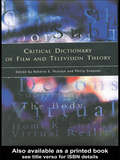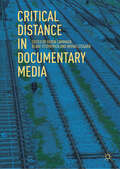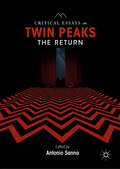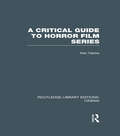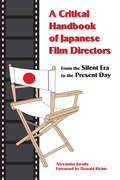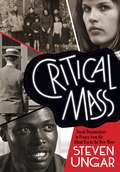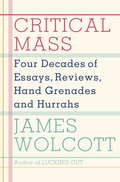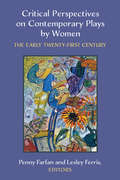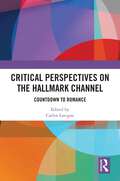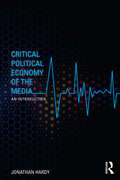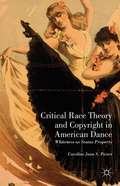- Table View
- List View
Crisis and Communitas: Performative Concepts of Commonality in Arts and Politics (Routledge Advances in Theatre & Performance Studies)
by Małgorzata Sugiera Dorota SajewskaThis book is a critical, transdisciplinary examination of a broad range of philosophical ideas, theoretical concepts, and artistic projects of community in the 20th and 21st century in the context of global/local social and political changes. This volume opens new vitas by focusing on carefully selected instances of multipronged crises in which existing concepts of commonality are questioned, reformulated, or even speculatively designed with a (better) future in view. As many authors of this volume argue, in the face of today’s unprecedented global ecological and economic challenges speculative design is of utmost importance as it can foster alternative, unthought-of forms of connectivity that go far beyond progressivist narratives of nation, corporation, and nuclear family. Focusing on the situations of upheaval, both historical and fabulated, the collection not only examines how multipronged crises trigger antagonisms between egalitarian forms of communitas and the normative concept of the nation (and other normative forms of communities) as a community that separates and excludes. It also looks closely at philosophical and artistic projects that strive to go beyond the dichotomies and typically extrapolated utopias, envisaging new political economies, ways of living and alternative relational structures. It will be of great interest to students and scholars in performance studies, cultural studies, political studies, media studies, postcolonial and decolonial studies, critical anthropology.
The Crisis of Political Modernism: Criticism and Ideology in Contemporary Film Criticism
by D. N. RodowickD.N. Rodowick offers a critical analysis of the development of film theory since 1968. He shows how debates concerning the literary principles of modernism—semiotics, structuralism, psychoanalysis, Marxism, and feminism—have transformed our understanding of cinematic meaning. Rodowick explores the literary paradigms established in France during the late 1960s and traces their influence on the work of diverse filmmaker/theorists including Jean-Luc Godard, Peter Gidal, Laura Mulvey, and Peter Wollen. By exploring the "new French feminisms" of Irigaray and Kristeva, he investigates the relation of political modernism to psychoanalysis and theories of sexual difference. In a new introduction written especially for this edition, Rodowick considers the continuing legacy of this theoretical tradition in relation to the emergence of cultural studies approaches to film.
Cristi Puiu (Contemporary Film Directors)
by Monica FilimonCristi Puiu's black comedy The Death of Mr. Lazarescu announced the arrival of the New Romanian Cinema as a force on the film world stage. As critics and festival audiences embraced the new movement, Puiu emerged as its lodestar and critical voice. Monica Filimon explores the works of an artist dedicated to truth not as an abstract concept, but as the ephemeral revelation of the fuller, ungraspable world beyond the screen. Puiu's innovative use of the handheld camera as an observer and his reliance on austere, restricted narration highlight the very limits of human understanding, guiding the viewer's intellectual and emotional sensibilities to the reality that has been left unfilmed. Filimon examines the director's ethics of epiphany not only in relation to the collective and personal histories that have triggered it, but also in dialogue with the films, texts, and filmmakers that have shaped it.
Cristina!: Confidencias de Una Rubia
by Cristina SaraleguiMeet Cristina the superstar. The granddaughter of the foremost publishing czar in Cuba, she fled as an adolescent to the United States after the revolution. A young woman working her way up through the ranks of the North American-based Spanish-language media, she eventually assumed the reins of Cosmopolitan en Espanol. After ten years with Cosmopolitan, Cristina made the boldest move of her career - creating and hosting El Show de Cristina, the talk show she has developed into the phenomenon seen by 100 million worldwide. Friend and confidante to celebrities both inside and outside the Hispanic world, she also hosts a radio show heard all over Latin America and publishes the magazine Cristina La Revista, read avidly by thousands of fans every month. "Meet Cristina the Motivator. Groundbreaker and role model for women everywhere - especially Latinas - she offers advice, based on the life she has lived and the wisdom she has earned, on overcoming racial and sexual discrimination... raising children... keeping a happy marriage... growing older gracefully... and the Winner's Ten Commandments."--BOOK JACKET.Title Summary field provided by Blackwell North America, Inc. All Rights Reserved
Critica Musica: Essays in Honour of Paul Brainard (Musicology)
by J. KnowlesThis is Volume 18 of eighteen in a book series on Musicology. Originally published in 1996, this is a collection of essays in honor or Paul Brainard. Critica Musica-thinking critically about music-is at the heart of Paul Brainard's long career, and of his legacy to his students, colleagues, and friends. As a scholar, performer, and teacher, Professor Brainard has embodied a thorough, meticulous, and reasoned approach to music and scholarship that has set a high standard for all who have come in contact with him.
Critical Acting Pedagogy: Intersectional Approaches (Routledge Advances in Theatre & Performance Studies)
by Lisa Peck Evi StamatiouCritical Acting Pedagogy: Intersectional Approaches invites readers to think about pedagogy in actor training as a research field in its own right: to sit with the complex challenges, risks, and rewards of the acting studio; to recognise the shared vulnerability, courage, and love that defines our field and underpins our practices. This collection of chapters, from a diverse group of acting teachers at different points in their careers, working in conservatoires and universities, illuminates current developments in decolonising studios to foreground multiple and intersecting identities in the pedagogic exchange. In acknowledging how their positionality affects their practices and materials, 20 acting teachers from the United Kingdom, the United States, Europe, and Oceania offer practical tools for the social justice acting classroom, with rich insights for developing critical acting pedagogies. Authors test and develop research approaches, drawn from social sciences, to tackle dominant ideologies in organisation, curriculum, and methodologies of actor training.This collection frames current efforts to promote equality, diversity, and inclusivity in the studio. It contributes to the collective movement to improve current educational practice in acting, prioritising well-being, and centering the student experience.
Critical Approaches to TV and Film Set Design
by Geraint D'ArcyThe analysis of scenic design in film and television is often neglected, with visual design elements relegated to part of the mise-en-scène in cinema or simply as "wallpaper" in television. Critical Approaches to TV and Film Set Design positions itself from the audience perspective to explore how we watch TV and film, and how set design enhances and influences the viewing experience. By using semiotics, history and narratology and adding concepts drawn from art, architecture and theatre, Geraint D’Arcy reworks the key concepts of set design. Looking at the impact of production design on how the viewer reads film and television, these updated theories can be applied more flexibly and extensively in academic criticism. D’Arcy creates a new theoretical approach, representing a significant expansion of the field and filling the remaining gaps. This book is ideal for anyone interested in understanding how we can read and interpret design in film and television, and should be the primary point of reference for those studying TV and film set design.
Critical Cinema: Beyond the Theory of Practice
by Clive MyerCritical Cinema: Beyond the Theory of Practice purges the obstructive line between the making of and the theorising on film, uniting theory and practice in order to move beyond the commercial confines of Hollywood. Opening with an introduction by Bill Nichols, one of the world's leading writers on nonfiction film, this volume features contributions by such prominent authors as Noel Burch, Laura Mulvey, Peter Wollen, Brian Winston and Patrick Fuery. Seminal filmmakers such as Peter Greenaway and Mike Figgis also contribute to the debate, making this book a critical text for students, academics, and independent filmmakers as well as for any reader interested in new perspectives on culture and film.
Critical Cinema: Beyond the Theory of Practice
by Myer Clive Ed.Critical Cinema: Beyond the Theory of Practice purges the obstructive line between the making of and the theorising on film, uniting theory and practice in order to move beyond the commercial confines of Hollywood. Opening with an introduction by Bill Nichols, one of the world's leading writers on nonfiction film, this volume features contributions by such prominent authors as Noel Burch, Laura Mulvey, Peter Wollen, Brian Winston and Patrick Fuery. Seminal filmmakers such as Peter Greenaway and Mike Figgis also contribute to the debate, making this book a critical text for students, academics, and independent filmmakers as well as for any reader interested in new perspectives on culture and film.
A Critical Cinema 2: Interviews with Independent Filmmakers
by Scott MacDonaldThis sequel to A Critical Cinema offers a new collection of interviews with independent filmmakers that is a feast for film fans and film historians. Scott MacDonald reveals the sophisticated thinking of these artists regarding film, politics, and contemporary gender issues.The interviews explore the careers of Robert Breer, Trinh T. Minh-ha, James Benning, Su Friedrich, and Godfrey Reggio. Yoko Ono discusses her cinematic collaboration with John Lennon, Michael Snow talks about his music and films, Anne Robertson describes her cinematic diaries, Jonas Mekas and Bruce Baillie recall the New York and California avant-garde film culture. The selection has a particularly strong group of women filmmakers, including Yvonne Rainer, Laura Mulvey, and Lizzie Borden. Other notable artists are Anthony McCall, Andrew Noren, Ross McElwee, Anne Severson, and Peter Watkins.
A Critical Companion to Lynn Nottage
by Jocelyn L. BucknerA Critical Companion to Lynn Nottage places this renowned, award-winning playwright's contribution to American theatre in scholarly context. The volume covers Nottage's plays, productions, activism, and artistic collaborations to display the extraordinary breadth and depth of her work. The collection contains chapters on each of her major works, and includes a special three-chapter section devoted to Ruined, winner of the 2009 Pulitzer Prize. The anthology also features an interview about collaboration and creativity with Lynn Nottage and two of her most frequent directors, Seret Scott and Kate Whoriskey.
A Critical Companion to Neil Gaiman's "Neverwhere" (Palgrave Science Fiction and Fantasy: A New Canon)
by Jeffrey Andrew WeinstockFantasy author Neil Gaiman’s 1996 novel Neverwhere is not just a marvelous self-contained novel, but a terrifically useful text for introducing students to fantasy as a genre and issues of adaptation. Jeffrey Andrew Weinstock’s briskly written A Critical Companion to Neil Gaiman’s Neverwhere offers an introduction to the work; situates it in relation to the fantasy genre, with attention in particular to the Hero’s Journey, urban fantasy, word play, social critique, and contemporary fantasy trends; and explores it as a case study in transmedial adaptation. The study ends with an interview with Neil Gaiman that addresses the novel and a bibliography of scholarly works on Gaiman.
Critical Dictionary of Film and Television Theory
by Roberta E. Pearson Philip SimpsonThe Critical Dictionary of Film and Television Theory clearly and accessibly explains the major theoretical approaches now deployed in the study of the moving image, as well as defining key theoretical terms.This dictionary provides readers with the conceptual apparatus to understand the often daunting language and terminology of screen studies. Entries include: *audience * Homi K. Bhabha * black cinema * the body * children and media * commodification * cop shows * deep focus * Umberto Eco * the gaze * Donna Haraway * bell hooks * infotainment * master narrative * medical dramas * morpheme * myth * panopticon * pastiche * pleasure * real time * social realism * sponsorship * sport on television * subliminal * third cinema * virtual realityConsultant Editors:David Black, USA, William Urricchio, University of Utrecht, The Netherlands, Gill Branston, Cardiff University, UK ,Elayne Rapping, USA
Critical Distance in Documentary Media
by Gerda Cammaer Blake Fitzpatrick Bruno LessardThis collection of essays presents new formulations of ideas and practices within documentary media that respond critically to the multifaceted challenges of our age. As social media, augmented reality, and interactive technologies play an increasing role in the documentary landscape, new theorizations are needed to account for how such media both represents recent political, socio-historical, environmental, and representational shifts, and challenges the predominant approaches by promoting new critical sensibilities. The contributions to this volume approach the idea of “critical distance” in a documentary context and in subjects as diverse as documentary exhibitions, night photography, drone imagery, installation art, mobile media, nonhuman creative practices, sound art and interactive technologies. It is essential reading for scholars, practitioners and students working in fields such as documentary studies, film studies, cultural studies, contemporary art history and digital media studies.
Critical Essays on Twin Peaks: The Return
by Antonio SannaThis edited collection offers an interdisciplinary study of Twin Peaks: The Return, the third season of a TV program that has attracted the attention (and appreciation) of spectators, fans, and critics for over two decades. The book takes readers into several distinct areas and addresses the different approaches and the range of topics invited by the multidimensionality of the subject itself: the philosophical, the artistic, the socio-cultural, and the personal. The eighteen chapters constituting the volume are academic in their approach to the subject and in their methodology, whether they apply a historical, psychoanalytical, film studies, or gender studies perspective to the text under examination. The variety and range of perspectives in these aforementioned chapters reflect the belief that a study of the full complexity of Twin Peaks: The Return, as well as a timely assessment of the critical importance of the program, requires both an interdisciplinary perspective and the fusion of different intellectual approaches across genres. The chapters demonstrate a collective awareness of the TV series as a fundamental milestone in contemporary culture.
The Critical Eye: An Introduction to Looking at Movies (3rd revised edition)
by Margo Kasdan Christine Saxton Susan TavernettiAn excellent summary and profound analysis of the techniques and interpretation of movies.
A Critical Guide to Horror Film Series (Routledge Library Editions: Cinema)
by Ken HankeIn this book the author takes a fresh look at horror film series as series and presents an understanding of how the genre thrived in this format for a large portion of its history. It sheds light on older films such as the Universal and the Hammer series films on Dracula, Frankenstein and the Mummy as well as putting more recent series into perspective, such as The Nightmare on Elm Street films. A well rounded review of these films and investigation into their success as a format, this useful volume, originally published in 1991, offers an attempt to understand the marriage of horror and the series film, with its pluses as well as minuses.
A Critical Handbook of Japanese Film Directors
by Alexander Jacoby Donald RichieThis important work fills the need for a reasonably priced yet comprehensive volume on major directors in the history of Japanese film. With clear insight and without academic jargon, Jacoby examines the works of over 150 filmmakers to uncover what makes their films worth watching.Included are artistic profiles of everyone from Yutaka Abe to Isao Yukisada, including masters like Kinji Fukasaku, Juzo Itami, Akira Kurosawa, Takashi Miike, Kenji Mizoguchi, Yasujiro Ozu, and Yoji Yamada. Each entry includes a critical summary and filmography, making this book an essential reference and guide.UK-based Alexander Jacoby is a writer and researcher on Japanese film.
Critical Mass: Social Documentary in France from the Silent Era to the New Wave
by Steven UngarThirty-five years of nonfiction films offer a unique lens on twentieth-century French social issuesCritical Mass is the first sustained study to trace the origins of social documentary filmmaking in France back to the late 1920s. Steven Ungar argues that socially engaged nonfiction cinema produced in France between 1945 and 1963 can be seen as a delayed response to what filmmaker Jean Vigo referred to in 1930 as a social cinema whose documented point of view would open the eyes of spectators to provocative subjects of the moment.Ungar identifies Vigo&’s manifesto, his 1930 short À propos de Nice, and late silent-era films by Georges Lacombe, Boris Kaufman, André Sauvage, and Marcel Carné as antecedents of postwar documentaries by Eli Lotar, René Vautier, Alain Resnais, Chris Marker, and Jean Rouch, associated with critiques of colonialism and modernization in Fourth and early Fifth Republic France. Close readings of individual films alternate with transitions to address transnational practices as well as state- and industry-wide reforms between 1935 and 1960. Critical Mass is an indispensable complement to studies of nonfiction film in France, from Georges Lacombe&’s La Zone (1928) to Chris Marker&’s Le Joli Mai (1963).
Critical Mass
by James WolcottA career-spanning collection of critical essays and cultural journalism from one of the most acute, entertaining, and sometimes acerbic (but in a good way) critics of our timeFrom his early-seventies dispatches as a fledgling critic for The Village Voice on rock 'n' roll, comedy, movies, and television to the literary criticism of the eighties and nineties that made him both feared and famous to his must-read reports on the cultural weather for Vanity Fair, James Wolcott has had a career as a freelance critic and a literary intellectual nearly unique in our time. This collection features the best of Wolcott in whatever guise--connoisseur, intrepid reporter, memoirist, and necessary naysayer--he has chosen to take on. Included in this collection is "O.K. Corral Revisited," a fresh take on the famed Norman Mailer-Gore Vidal dustup on The Dick Cavett Show that launched Wolcott from his Maryland college to New York City (via bus) to begin his brilliant career. His prescient review of Patti Smith's legendary first gig at CBGB leads off a suite of eyewitness and insider accounts of the rise of punk rock, while another set of pieces considers the vast cultural influence of the enigmatic Johnny Carson and the scramble of his late-night successors to inherit the "swivel throne." There are warm tributes to such diverse figures as Michael Mann, Sam Peckinpah, Lester Bangs, and Philip Larkin and masterly summings-up of the departed giants of American literature--John Updike, William Styron, John Cheever, and Mailer and Vidal. Included as well are some legendary takedowns that have entered into the literary lore of our time. Critical Mass is a treasure trove of sparkling, spiky prose and a fascinating portrait of our lives and cultural times over the past decades. In an age where a great deal of back scratching and softball pitching pass for criticism, James Wolcott's fearless essays and reviews offer a bracing taste of the real critical thing.
Critical Perspectives on Contemporary Plays by Women: The Early Twenty-First Century
by Penny Farfan Lesley FerrisThis book foregrounds some of the ways in which women playwrights from across a range of contexts and working in a variety of forms and styles are illuminating the contemporary world while also contributing to its reshaping as they reflect, rethink, and reimagine it through their work for the stage. The book is framed by a substantial introduction that sets forth the critical vision and structure of the book as a whole, and an afterword that points toward emerging currents in and expansions of the contemporary field of playwriting by women on the cusp of the third decade of the twenty-first century. Within this frame, the twenty-eight chapters that form the main body of the book, each focusing on a single play of critical significance, together constitute a multifaceted, inevitably partial, yet nonetheless integral picture of the work of women playwrights since 2000 as they engage with some of the most pressing issues of our time. Some of these issues include the continuing oppression of and violence against women, people of color, LGBTQ+ people, and ethnic minorities; the ongoing processes of decolonization; the consequences of neoliberal capitalism; the devastation and enduring trauma of war; global migration and the refugee crisis; the turn to right-wing populism; and the impact of climate change, including environmental disaster and species extinction. The book is structured into seven sections: Replaying the Canon; Representing Histories; Staging Lives; Re-imagining Family; Navigating Communities; Articulating Intersections; and New World Order(s). These sections group clusters of plays according to the broad critical actions they perform or, in the case of the final section, the new world orders that they capture through their stagings of the seeming impasse of the politically and environmentally catastrophic global present moment. There are many other points of resonance among and across the plays, but this seven-part structure foregrounds the broader actions that drive the plays, both in the Aristotelian dramaturgical sense and in the larger sense of the critical interventions that the plays creatively enact. In this way, the seven-part structure establishes correspondences across the great diversity of dramatic material represented in the book while at the same time identifying key methods of critical approach and areas of focus that align the book’s contributors across this diversity. The structure of the book thus parallels what the playwrights themselves are doing, but also how the contributors are approaching their work. Plays featured in the book are from Canada, Australia, South Africa, the US, the UK, France, Argentina, New Zealand, Syria, Brazil, Italy, and Austria; the playwrights include Margaret Atwood, Leah Purcell, Yaël Farber, Paula Vogel, Adrienne Kennedy, Suzan-Lori Parks, debbie tucker green, Lisa Loomer, Hélène Cixous, Anna Deavere Smith, Lola Arias, Lisa Kron and Jeanine Tesori, Marie Clements, Quiara Alegría Hudes, Alia Bano, Holly Hughes, Whiti Hereaka, Julia Cho, Liwaa Yazji, Grace Passô, Dominique Morisseau, Emma Dante, Frances Ya-Chu Cowhig, Lynn Nottage, Elfriede Jelinek, Caryl Churchill, Colleen Murphy, and Lucy Kirkwood. Encompassing several generations of playwrights and scholars, ranging from the most senior to mid-career to emerging voices, the book will be essential reading for established researchers, a valuable learning resource for students at all levels, and a useful and accessible guide for theater practitioners and interested theater-goers.
Critical Perspectives on the Hallmark Channel: Countdown to Romance
by Carlen LavigneThis multinational, multidisciplinary collection of essays focuses on Hallmark Channel movies and Hallmark’s position in the changing North American media landscape.This book covers the ‘Countdown to Christmas’ offerings, year-round productions, made-for-TV mysteries and romances, Hallmark’s use of specific filming locations, and its relationship to viewer desires. Chapters examine Hallmark’s position in a changing sociopolitical context and the tensions the company must navigate in creating more “progressive” content; they discuss issues of gender, race, sexuality, and place, as well as analyzing the extensive ranges and reactions of social media participants and interrogating the nature of Hallmark’s popularity.Suitable for scholars and students of film and tv and popular culture studies, this is a multifaceted look at both Hallmark and its viewers at a particular moment of Hallmark’s market dominance.
Critical Political Economy of the Media: An Introduction (Communication and Society)
by Jonathan HardyHow the media are organised and funded is central to understanding their role in society. Critical Political Economy of the Media provides a clear, comprehensive and insightful introduction to the political economic analysis of contemporary media. Jonathan Hardy undertakes a critical survey of political economy scholarship encompassing worldwide literature, issues and debates, and relationships with other academic approaches. He assesses different ways of making sense of media convergence and digitalisation, media power and influence, and transformations across communication markets. Many of the problems of the media that prompted critical political economy research remain salient, he argues, but the approach must continue to adapt to new conditions and challenges. Hardy advances the case for a revitalised critical media studies for the 21st century. Topics covered include: media ownership and financing news and entertainment convergence and the Internet media globalisation advertising and media alternative media media policy and regulation Introducing key concepts and research, this book explains how political economy can assist students, researchers and citizens to investigate and address vital questions about the media today.
Critical Race Theory And Copyright In American Dance
by Caroline Joan S. PicartThe effort to win federal protection for dance in the United States was a racialized and gendered contest. Picart traces the evolution of choreographic works from being federally non-copyrightable to becoming a category potentially copyrightable under the 1976 Copyright Act, specifically examining Lo#65533;e Fuller, George Balanchine, and Martha Graham.
Critical Readings on Hammer Horror Films (Routledge Advances in Horror)
by Fernando Gabriel Pagnoni Berns Matthew EdwardsThis collection offers close readings on Hammer’s cycle of horror films, analysing key films and placing particular emphasis on the narratives and themes present in the works discussed.Ranging from the studio’s first horror outing, The Mystery of the Mary Celeste (1935) to Hammer’s last contemporary film, Doctor Jekyll (2023), the collection celebrates cult-favourites such as The Quatermass Experiment, the films of Terence Fisher, to overlooked classics such as Captain Clegg or The Mummy franchise. This volume also delves into Hammer’s psychological thrillers, the studio’s venture into TV with Hammer’s House of Horrors, with theoretical frameworks varying from queer studies to postcolonial readings.This volume will appeal to scholars and students of film studies, international cinema, film history and horror studies.
